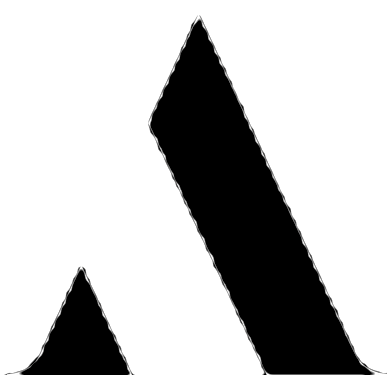Alekhine’s tribute to Nimzowitsch
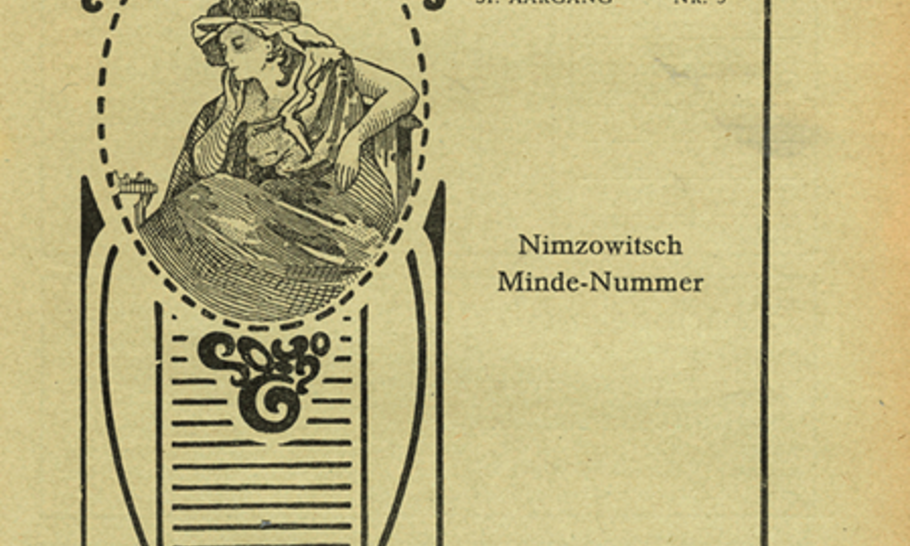
I am grateful to Alexei Zakharov, a vital contributor to the recent outstanding opening salvo in the Elk and Ruby tetralogy on Alexander Alekhine, for drawing my attention to the great world champion’s virtually unknown obituary on the sadly premature death of Aron Nimzowitsch, the grandmaster and theoretician who was born in Riga (now Latvia, then part of the Russian Empire) but after 1917 became a Danish citizen. The obituary originally appeared in a special tribute issue of Skakbladet, the Danish Chess Magazine, in 1935.
Alekhine’s comments on Nimzowitsch, who was Jewish, are a useful corrective to his notorious wartime anti-Semitic diatribe in the Nazi Pariser Zeitung — a rant against such Jewish chess champions as Lasker, Fine, Reshevsky, Spielmann, Rubinstein, Tarrasch and Nimzowitsch himself. (See my article on Alekhine here.) Alekhine’s opportunistic attempt to curry favour with the deluded Myrmidons of the Third Reich come across as demonically inebriated Jekyll and Hyde ravings, when compared to his balanced and nuanced appreciation a few years earlier at the death of Nimzowitsch, his illustrious colleague and perennial rival:
“I think it is unnecessary to repeat once again that the chess world has suffered a great loss with Nimzowitsch’s death. But I would like to add, perhaps the greatest. For Nimzowitsch was not only one of the truly greats as a practical artist, but, above all, the first who in the 20th century opened new paths for scientific chess, and that is what will also make his name unforgettable in the future among all chess enthusiasts.
And we, his contemporaries, will always remember that at a time in the history of chess (approx. 1900-1912), when chess philosophical thought had come to a dangerous standstill after Steinitz’s death, and when the so-called death by draw threatened our chess game much, much more than today, there came a man who understood how to find what had lasting value in Steinitz’s partly exaggerated theories, and explained it to the chess world in a series of effective articles (Wiener Schachzeitung, 1912-1913).
What was it then, this new, eternal truth, about the structure of a chess masterpiece? Actually something quite simple, something obvious, which had simply never been said before Nimzowitsch. Namely the fact that not only during the game in general, but especially in the opening battle for the centre, it is far more important to control the squares, than to occupy them.
The further development of this idea, which Nimzowitsch carried out in two very important books in didactic terms, My System and Chess Praxis, brought the chess world a collection of new formulas and new concepts, such as blockade, overprotection, the rule of two weaknesses, etc.
As a fighter and practical player, Nimzowitsch lacked nothing, in my opinion. If he did not reach the highest levels, (i.e. become world champion) this was only due to his artistic hypersensitivity. But in the practical field too, he has created lasting values.
The great ones of the last times are becoming fewer and fewer, and each new loss is more painful. We need new great gifts, and they will come.
Honour be to the memory of the great artist and the often passionate, but always upright and noble-minded man Aron Nimzowitsch.”
The Danish magazine in question (Skakbladet, May 1935) also contains a useful summary of Nimzowitsch’s results against all top players, as well as his most impressive tournament results.
Here is a summary of that summary, facts which should be sufficient to silence any ill judged derogatory disrespect to Nimzowitsch and his theories, surprisingly voiced by such contemporary commentators as Seirawan and Gustafsson. It’s encouraging that in the pro-Nimzowitsch corner we find figures of undoubted authority, including such Grandmasters and Champions as Petrosian, Larsen and Hjartarson.
I have compiled a couple of lists that amply demonstrate the prowess of Nimzowitsch over three decades. The first list shows tournaments , where he was awarded the first prize:
Munich tournament, 1906
Russian championship, Petrograd, 1914
Marienbad tournament, 1925
Dresden tournament, 1926 (ahead of Alekhine and Rubinstein)
Hanover tournament, 1926
Bad Niendorf tournament, 1927
London international tournament, 1927 (ahead of Marshall and Bogoljubov)
London 1927 (UK opponents only)
Berlin BSG tournament, 1928 (ahead of Bogoljubov, Tartakower and Reti)
Carlsbad tournament, 1929 (ahead of Capablanca, Spielmann, Rubinstein, Euwe and Bogolyubov)
Frankfurt tournament, 1930
Winterthur Swiss championship, 1931
Plus Copenhagen: 1922, 1923, 1924, 1928 (twice) 1933 and 1934.
Against his leading opponents, Nimzowitsch laid claim to some compelling overall scores:
Euwe: one win no losses
Flohr: two wins no losses
Janowski: three wins no losses
Lasker: one win no losses
Maroczy: one win no losses
Tchigorin: one win no losses
Tarrasch: five wins two losses
Tartakower: five wins three losses
Reti: five wins one loss
Sultan Khan: one win no losses
Spielmann: eighteen wins fifteen losses
Marshall: six wins five losses.
Awarded the tournament’s best game prize, there can be no better concluding point than Nimzowitsch’s brilliant flight of fancy against one of his regular top-notch opponents, Akiba Rubinstein. And especially watch out for the outlandish human move 18!
Aron Nimzowitsch vs. Akiba Rubinstein
International tournament, Dresden, 1926, rd. 5
Notes by Ray Keene and augmented by Pancho*
- c4 c5 2. Nf3 Nf6 3. Nc3 d5 4. cxd5 Nxd5 5. e4 Nb4 6. Bc4 e6 7. O-O N8c6 8. d3 Nd4
Presumably staking out new territory for both players.
- Nxd4 cxd4 10. Ne2 a6 11. Ng3 Bd6?!
Both, 11… Be7 12. f4 O-O 13. a3 Nc6 14. Bd2 and, 11… Nc6 12. a3 g6 13. Bd2 Bg7 14. f4 were more robust continuations.
- f4 O-O 13. Qf3?
Wrongly discarding a comfortable initiative. For example, after 13. a3 b5 14. Bb3 Nc6 15. Qh5 Kh8 16. e5 Be7 17. Ne4 g6 18. Qh6 Rg8 19. Bd2 Bb7, White is the more active player.
13… Kh8 14. Bd2 f5 15. Rae1 Nc6 16. Re2 Qc7 17. exf5 exf5 18. Nh1!!

A wonderful idea, though the simple and thematic 18. Rfe1 also has its points. With the text White has in mind the far sighted manoeuvre Nh1-f2-h3-g5, in conjunction with Qh5, as a method of assaulting the position of Black’s king. When I first read My System I was so impressed by this game that I deliberately created situations in my next few games where the move Ng3-h1 was possible, in the belief that this mystical retreat would somehow result in a miraculous increase of energy in my position, irrespective of whatever else may have been happening on the board at the time.
18… Bd7 19. Nf2 Rae8 20. Rfe1 Rxe2 21. Rxe2 Nd8 22. Nh3 Bc6 23. Qh5 g6 24. Qh4 Kg7 25. Qf2
Another brilliant idea. The threat to the d-pawn forces Black to withdraw either his queen or his king’s bishop from the defence of his kingside.
25… Bc5 26. b4?
A premature foray loses ground to Black. Best was, 26. Ng5 Re8 27. Rxe8 Bxe8 28. b4! when White’s pieces are active and enjoy more space than the static forces of his opponent.
26… Bb6??
The text move should prove to be the losing manoeuvre. After, 26… Be7 27. Ng5 Bf6 28. Nf3 Qd6 29. Ne5 b5 30. Bb3 Re8, Black has contained White’s attack and emerged unscathed.
- Qh4
Back again and with redoubled strength.
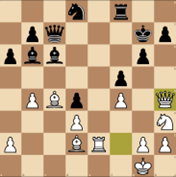
But in retrospect, White may have regretted not continuing with the definitively destructive, 27. Qe1!! which, unlike the text move, prevents the defensive resource, 27… Re8. Black must defend against the immediate threat of 28. Re7+!! winning the queen. If 27… Be4 (27… Nf7 28. Re7 Qxe7 29. Qxe7) 28. Ng5, with the following:
- a) 28… Qd7 (or, 28… h5) 29. Nxe4 fxe4 30. Rxe4 Nc6 31. a4;
- b) 28… Qd6 29. Nxe4 fxe4 30. Rxe4 Rxe4 (30… Qf6 31. Re7+ Kh8 32. Qe5 h6 33. Qxf6+ Rxf6 34. a4) 31. Qxe4 Kf8 32. Qd5 Nf7 33. Qe6 Ba7 34. Bd5 Qe7 35. Qxe7+;
- c) 28… Re8 29. Nxe4 Rxe4 30. Rxe4 fxe4 31. Qxe4 Kf8 32. Qd5 Nf7 33. Qe6 Ba7 34. Bd5 Qe7 35. Qxe7+; after any of which, White is incontrovertibly winning.
27… Re8
Or 27… Rf6 28. Ng5 h6 29. Nh7 +-.
- Re5!
My exclamation mark. However…The cold blooded engine reassesses this move as 28. Re5? giving as justification, the improvement: 28. Rxe8! Bxe8 29. Ng5 h5 30. g4 Qd6 31. gxf5 gxf5 32. Kf1 Bc7 33. Qg3 Kh6 34. Nf3 Qg6 35. Nxd4, when White is very much better.
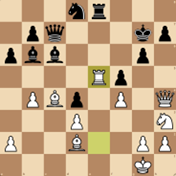
28… Nf7??
If 28… Rxe5 29. fxe5 Qxe5 30. Qh6+ or 28… h6 29. g4 hxg4 30. f5 Qxe5 31. f6+ Qxf6 32. Qxh6 mate. These beautiful variations are just an indication of what Nimzowitsch saw. However, following on from the last comment, one has to ask what Nimzowitsch had in mind against, 28… Qd7! as it seems that neither 29. g4 nor a4 offers White much in the way of traction.
- Bxf7 Qxf7 30. Ng5 Qg8 31. Rxe8 Bxe8 32. Qe1!
A decisive change of front.
32… Bc6 33. Qe7+ Kh8 34. b5!!
Again, my exclamation marks of approbation. Who would expect the death-blow to come from this quarter? If Black plays 34… axb5 he is mated as follows: 35. Ne6 h5 36. Qf6+ Kh7 37. Ng5+ Kh6 38. Bb4! In view of this, Rubinstein elects to surrender a piece but that too is obviously without hope.
While the above holds true, the vacating of the b4 square for a subsequent Bb4 does not, sadly, elevate the 34th move to a pedestal. The move recommended by the computer as truly deserving the doubled exclamations, is the immediate, 34. Ne6!! when if, 34… Bd8 35. Nxd8 Qg7 36. Nxc6, then 36… Qxe7 (36… Kg8 37. Qe6+ Kh8 38. Ne7 h6 39. Nxg6+ Kh7 40. Ne5 Kh8 41. Kf1 b5 42. Qxf5; or, 36… bxc6?? 37. Qd8+ Qg8 38. Qxd4+ Qg7 39. Qd8+ Qg8 40. Bc3#) 37. Nxe7 Kg7 38. Nd5 Kf7 39. Nc7 Kf6 40. b5 axb5 41. Nxb5 Ke6 42. Nxd4+, and White, two pieces ahead, has a winning endgame.
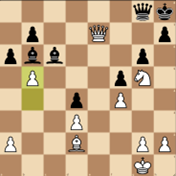
34… Qg7 35. Qxg7+ Kxg7 36. bxc6 bxc6 37. Nf3 c5 38. Ne5 Bc7 39. Nc4 Kf7 40. g3 Bd8 41. Ba5 Be7 42. Bc7 Ke6 43. Nb6 h6 44. h4 g5 45. h5 g4 46. Be5 Black resigns 1-0
Pancho* is the pet name for our friendly Stockfish 17.1 engine that assists the analysis of our game’s moves.
Ray’s 206th book, “ Chess in the Year of the King ”, written in collaboration with Adam Black, and his 207th, “ Napoleon and Goethe: The Touchstone of Genius ” (which discusses their relationship with chess) can be ordered from both Amazon and Blackwells. His 208th, the world record for chess books, written jointly with chess playing artist Barry Martin, Chess through the Looking Glass , is now also available from Amazon.
As noted above….Another new book from the Elk and Ruby publishing house is now also available from Amazon, with new information, original documents and fresh insights, Alexander Alekhine, The Russian Sphinx, Volume 1 , by Sergey Voronkov, with input from Alexei Zakharov.
A Message from TheArticle
We are the only publication that’s committed to covering every angle. We have an important contribution to make, one that’s needed now more than ever, and we need your help to continue publishing throughout these hard economic times. So please, make a donation.

